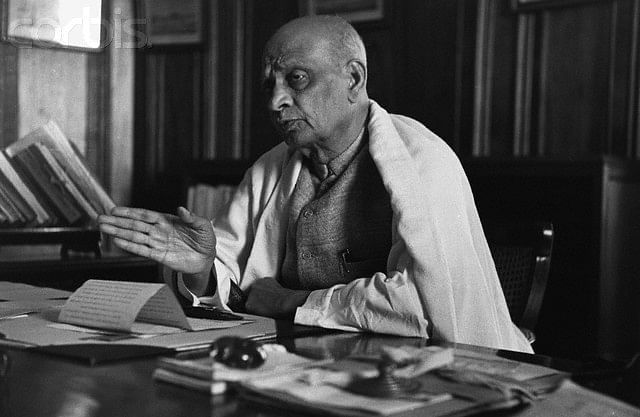Vallabhbhai Jhaverbhai Patel, popularly known as Sardar Patel, was a freedom fighter with a difference. He was a supporter of self-reliance, not independence, and he believed India would have collapsed into civil war if not for the Partition. The ‘iron man’s’ legacy far exceeds his 597 ft tall statue in Gujarat. He is the man who brought 500 princely states together, giving the idea of India a definite shape.
Background
At 16, Patel moved to Petlad, a small town just over 10 km from his village, to learn English. That’s also the age he got married to Javerbai. The couple went on to have two children — Mani, a girl and Dahya, a boy — before Javerbai passed away in 1908, when Patel was 33. He remained a widower for the rest of his life.
Career as a lawyer
After completing his matriculation at 22, he passed the district pleader’s [government lawyer’s] examination.
He then began to practise law, setting up his independent office in Godhra. Two years later, he moved to Borsad, before going to Middle Temple, London, in 1910 for further study in law.
He returned to India in February 1913 and served as a well-known criminal lawyer in Ahmedabad. Patel was not attached to the Indian freedom struggle till 1917.
Entry into the freedom struggle
In 1918, inspired by Mahatma Gandhi, Patel tried to lose the image of a wealthy barrister and began to campaign for farmers.
He played a major role in mobilising the Kheda Satyagraha of 1918, which was led by Gandhi to protest against the high taxes levied by the British on farmers despite crop failure due to heavy rains and the plague epidemic.
Patel was considerably influenced by Gandhi’s idea of satyagraha to protest against the British rule.
In 1922, 1924 and 1927, he was elected the municipal president of Ahmedabad.
It was in the wake of Patel’s campaign in Bardoli, Gujarat, against increased taxes for flood- and famine-hit farmers in 1928 that he earned the title of “sardar”.
This participation cemented his image as a nationalist, and brought him on the British radar.
On 7 March 1930, a day before the date for the Salt Satyagraha was to be announced by Mahatma Gandhi, the British arrested Patel at a village in Borsad taluka over fears that his speech might help to amplify the campaign.
By 1942, he was suffering from poor health but Patel still played a major role in galvanising the masses in the Quit India movement.
Addressing a large gathering of over 100,000 people assembled at Gowalia Tank in Bombay (now Mumbai), he called on people to organise a mass protest against the British government as well as a shutdown of civil services. In August 1942, Patel was imprisoned.
Also read: Shaheed Bhagat Singh, the freedom fighter everyone loves
Political philosophy
Patel’s ideology was quite different from that of other freedom fighters such as Jawaharlal Nehru and Subhas Chandra Bose. He was a proponent of India attaining a dominion status within the British government, and not total Independence.
Patel did not accept the post of Congress presidency during the 1929 Lahore session of the Indian National Congress, a bid to pressure the party to withdraw the resolution of independence.
However, ultimately Nehru became Congress president and the resolution was passed.
Patel was also against any kind of armed rebellion as he thought such measures could lead to a violent retaliation from the British government.
He agreed with Gandhi on the points of self-reliance, but did not see Hindu-Muslim unity as a prerequisite for Independence.
Patel also differed with Gandhi on the issue of Partition, as he believed the alternative was civil war.
Role in integration
Patel served as India’s first deputy Prime Minister and home minister following Independence. He played a major role in integrating over 500 princely states with the union of India, and is, therefore, known as the ‘Iron Man’ of India.
The Indian Independence Act, 1947, which provided for the lapse of paramountcy of the British crown over Indian states, gave each of the states the option to join India or Pakistan or to continue as independent sovereign entities. While some of these princely states, such as Jammu & Kashmir and Hyderabad, were larger than a few European countries, others comprised only a few villages – together they accounted for about two-fifths of Indian territory.
A new state department was set up, which was headed by Patel and had V.P. Menon as secretary, with the responsibility to bring together the princely states into the Indian union.
Although some states such as Bikaner and Baroda were quick to join the union, a few, including Junagadh and Hyderabad, initially declined. Patel and his team, however, managed to integrate 565 princely states with the union.
Also read: Savitribai Phule’s birth anniversary was once mooted to be India’s second Teacher’s Day
Patel died on 15 December 1950 at Birla House in Bombay, aged 75, after a massive heart attack. The government of India observed state mourning for a week following his death, and he was posthumously awarded India’s highest civilian award – Bharat Ratna – in 1991.






